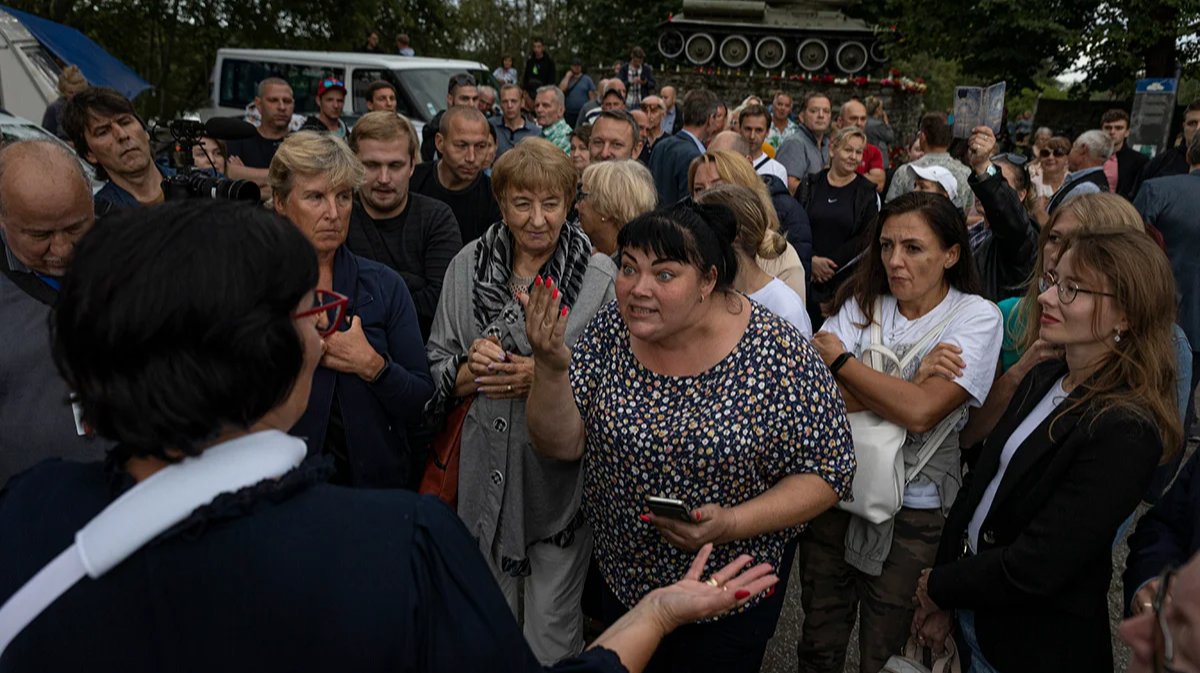In the morning of 16 August, 7 Soviet monuments were taken down in Narva, a Russian-speaking Estonian city, and the neighbouring town of Narva-Jõesuu, with the most prominent of them being a T-34 tank that was put on a pedestal in Narva in 1970 to commemorate the 25th anniversary of the World War II victory. The move stirred up so many emotions that even the border checkpoint with Russia had to be closed for several hours. The decision to dismantle the monuments was taken on the national level and practically put the Narva leadership and the Estonian government at odds with each other.
The government decision to take down the Soviet artifacts was predictable but an unexpected one, nonetheless. On the same day, members of the Narva city council were supposed to start debating the plan of the tank removal. According to the plan, the tank was supposed to be stored in Narva until a new museum is built to house it.
The monument used to be located on a small strip of land between the Narva River and a highway. This is the exact place where Soviet troops crossed the river in July 1944 and liberated the city from fascist soldiers. Many residents of Narva, a city situated right on the border with Russia, saw the tank as an important symbol of the Soviet people’s victory over Nazi Germany. Locals got used to laying flowers at the monument on the 9th of May, Victory Day. Newly-weds often took traditional wedding photos near the tank and tied ribbons to its cannon.
Just before removing the monument, the police turned off the camera that was broadcasting live from the scene round the clock for a city portal.
The city authorities set up the camera to pacify the locals. All opponents of the removal could see that the tank was still on its pedestal, and nobody was doing anything to take it down. In the end, the only people who could watch this historic occasion, the removal of the last Soviet tank monument in Estonia, were a few journalists who managed to get to the site in time, the police and military personnel.
The whole process took approximately 3 hours. The tank and the pedestal were loaded onto a military truck with a long trailer and taken to the other end of the country, the Estonian War Museum in Viimsi.
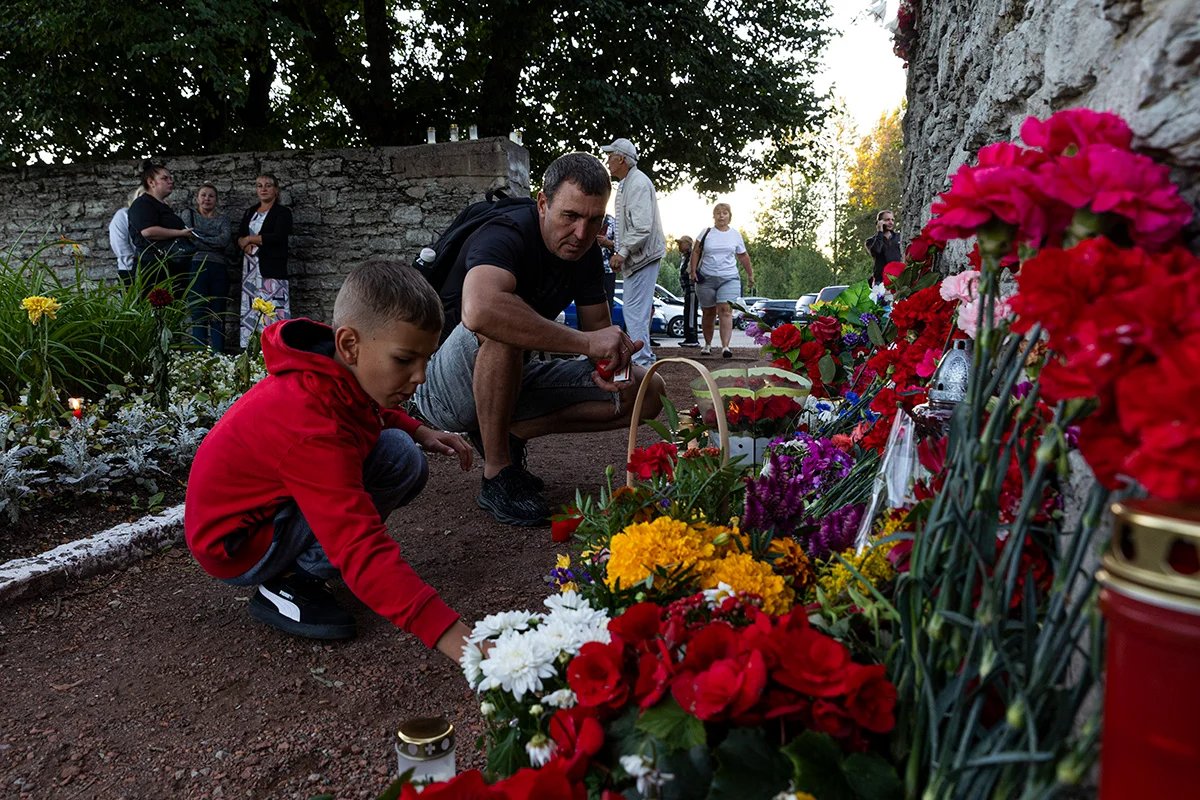
Photo by Vlad Dokshin / Especially for Novaya Gazeta.EuropePhoto by Vlad Dokshin / Especially for Novaya Gazeta.Europe
Remembrance
Just a week ago, the tank was standing in its place covered by flowers, mostly red carnations, and adorned by candles. People swarmed the tank immediately after Estonian Prime Minister Kaja Kallas announced in early August that all “memorials with symbols of the occupation [Soviet in this case] authorities” should be removed from public spaces.
A trailer was delivered to the parking lot near the monument where people were sleeping. They were anxious that the tank would be taken down and driven to a destination unknown under the guise of night. A blue tent was set up nearby with a small table underneath. Monument defenders sat around it.
They were all unanimously saying that it was not a rally or a move to protect the monument from a potential removal, they rather came to oversee public order. “It is easy to run into some kind of provocation, and we definitely don’t want this to happen, we don’t want another Bronze Night (mass unrest in 2007 over the relocation of a monument to Soviet troops in Tallinn that led to a harsh police crackdown and the death of Russian national Dmitry Ganin in a street fight — Novaya Gazeta. Europe). People carrying certain placards and even flags are constantly coming here, but they see us and realize that they won’t be able to stage a provocation and leave,” a stocky bald man, 50, wearing blue jeans and a grey T-shirt told me. He was one of those who regularly came to the tank “to prevent a situation that would free the government’s hands.”
Dozens of people would gather round the T-34 tank in the evenings. Before approaching the monument, newcomers took a long time to greet everyone there and discuss the latest news about the planned removal.
The atmosphere around the tank when there were no politicians and, naturally, a lot of reporters did not resemble that of a protest rally. It was more of a celebration or a day of remembrance. No one was shouting slogans, some people were coming to take pictures, lay flowers or place a candle. Others were flocking together in groups, seniors were quietly sitting on a bench and staring into the distance.
There are families in Narva whose ancestors fought in the Battle of Narva. They view tthe decision to remove the monument as a personal affront.
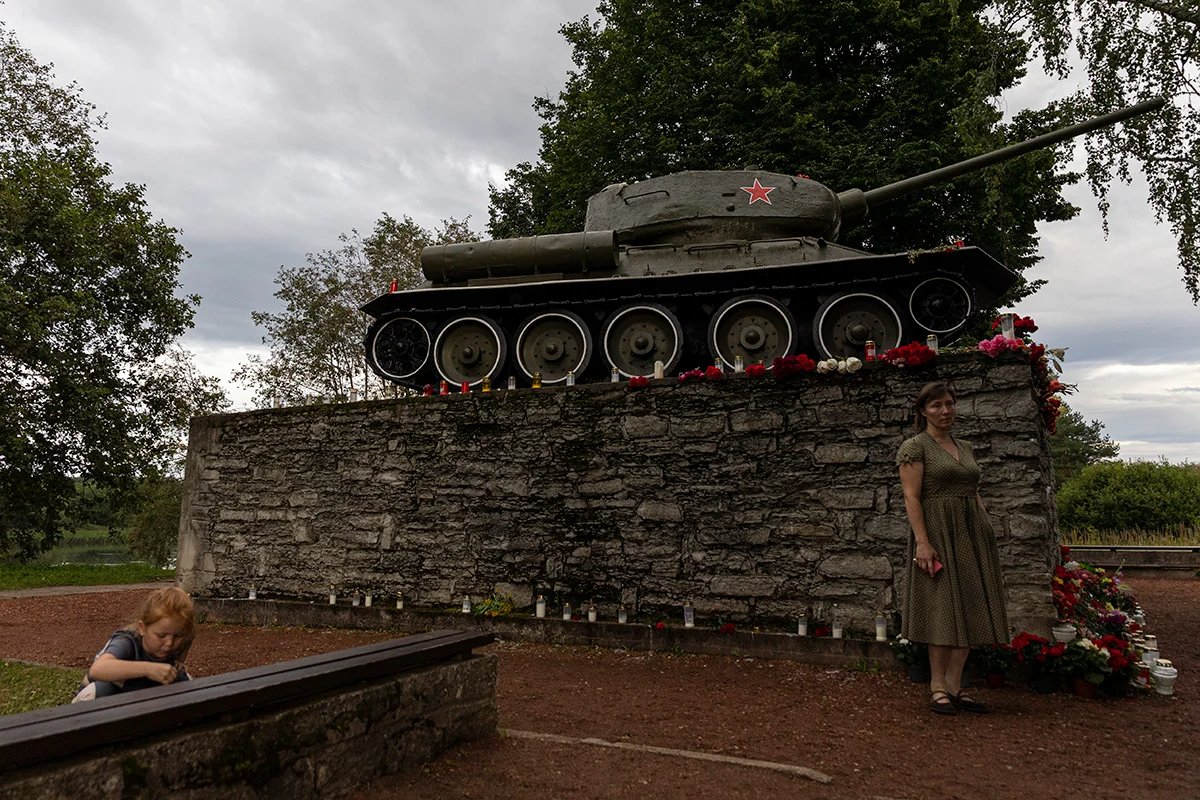
Photo by Vlad Dokshin / Especially for Novaya Gazeta.Europe
“I want to see the tank one more time before it’s taken down, to honour the memory of our ancestors. We try to come as often as possible because each time can be the last,” I was told by a young man who came to see the monument with his wife. Many of those opposing the government decision took their kids with them who were also actively taking pictures near the tank and echoing adults in saying that they were “deprived of memories.”
‘Pain of the other part’
One week before the tank was removed, Prime Minister Kaja Kallas travelled to Narva to discuss the sensitive issue of the Soviet monuments with local politicians. Following the meeting, members of the Narva city council and Mayor Katri Raik spoke about finding a compromise which would satisfy both the city residents and the national government. Meanwhile, Kallas once again stressed that the tank should be removed as soon as possible because “the symbol of occupation pains both those who suffered at the hands of the regime and those who see it as a symbol of cruel crimes that are now committed against Ukraine.”
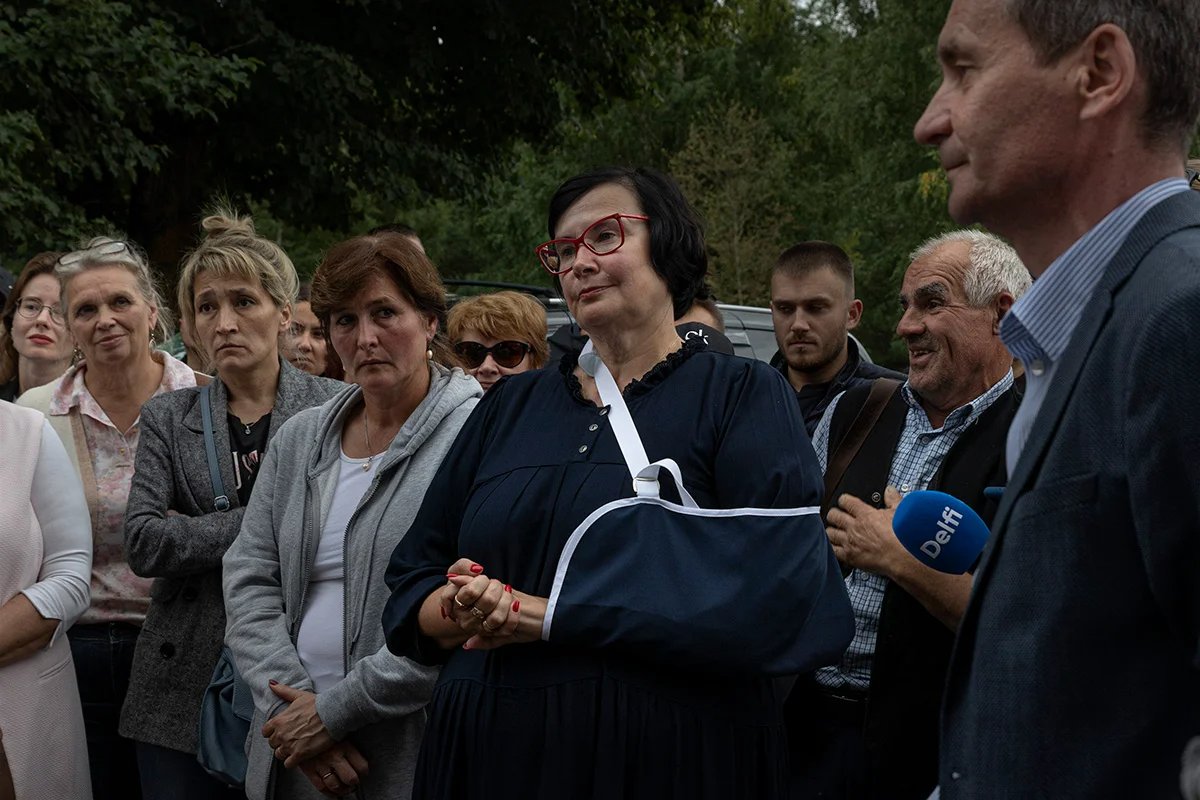
Mayor of Narva Katri Raik (center). Photo by Vlad Dokshin / Especially for Novaya Gazeta.Europe
In the evening after the prime minister’s Narva visit, several city council members and the mayor came to the tank. The politicians were immediately swarmed by a crowd of people.
Raik is a tall dashing woman with short dark hair, she is wearing glasses in a red frame and a long dark pinafore dress. Her left arm is in a cast, it is supported by a shoulder sling that matches her dress colour. Raik is 54, she is ethically Estonian and speaks Russian with an accent. She assumed the mayor’s office two years ago and previously served as the Estonian Interior Minister and headmistress of the Narva College. She has a degree in history and was particularly studying the history of Narva where she has lived for the last 20 years.
“A month ago, I said that the monument cannot be touched. And was steamrolled by Estonian media. Steamrolled!” Raik says emotionally with lots of hand gestures, forgetting about her cast. “I said that Narva residents do not want anything to happen to the monument, said that there are more pressing issues in the city and suggested to the government that the tank should be left alone. But Estonian society sees it differently…”
“Stop, stop, stop!” a tanned woman with short fair hair, seemingly the same age as Raik, joins the conversation. She is wearing a tracksuit jacket, leggings, and sneakers. “Why are we being split like that? Am I not a part of Estonian society?”
“The Estonian-speaking [part], let’s put it like this,” the mayor is trying to explain.
“And so what? My grandad was shot dead in [small northeast Estonian town of] Sillamäe on the KGB orders on 22 June 1941. So, I very much understand what Estonians [whose relatives also suffered from the actions of the Soviet authorities] feel,” the woman’s voice turns harsher, she punches her words. At times, she is overcome with emotions, she needs to catch her breath to finish sentences. You can see that she is trying hard not to start shouting.
“I cannot understand why one is mixed with the other (the feat of Soviet soldiers and actions of the Soviet Union as a state — Novaya Gazeta. Europe). Explain it to me as a historian.”
“Local Estonians and local Russians have different ideas about history. We cannot change it and can only accept it,” the politician calmly explains.
“Why then only the pain of one part of the society is taken into account, while the other is brushed aside in a democratic state? Why is the government doing it?” the blonde woman asks.
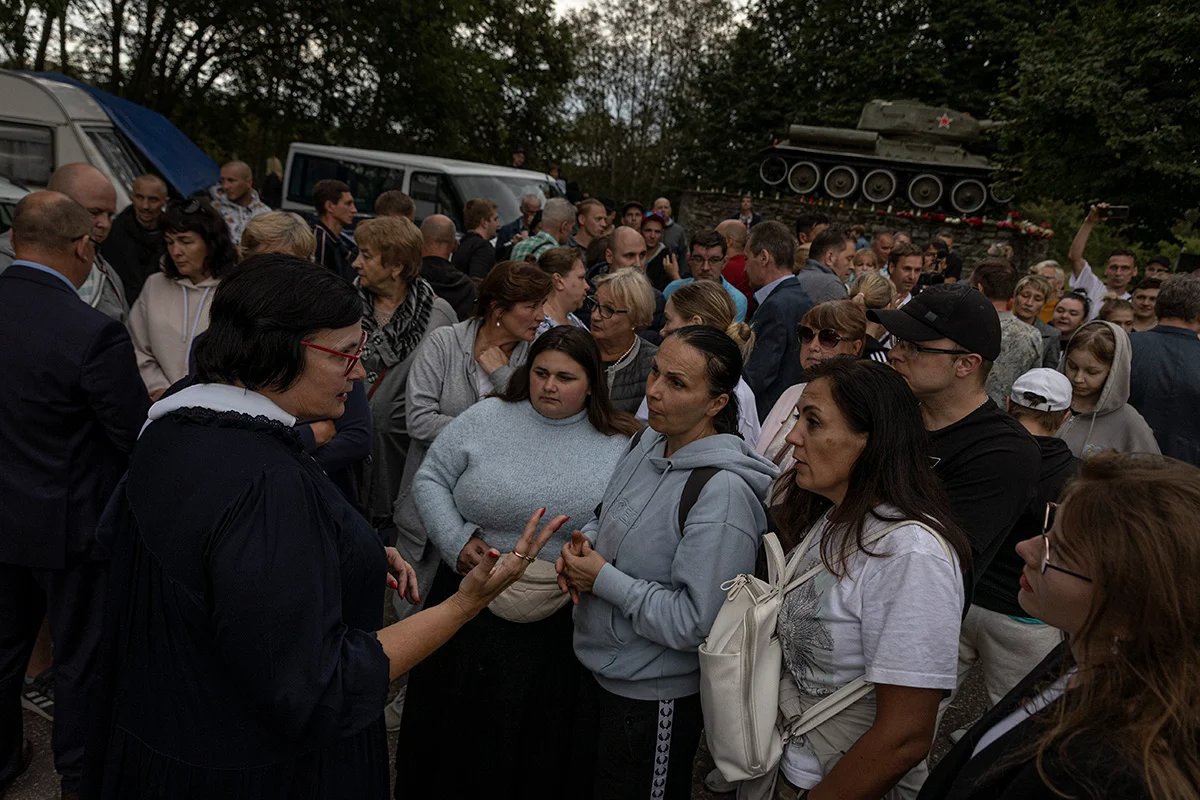
Photo by Vlad Dokshin / Especially for Novaya Gazeta.Europe
Raik hangs her head and purses her lips. It is clear that she is uncomfortable speaking about this loaded topic. However, she maintains her confident posture and continues.
“[The pain of the other part of the society] was taken into account before the war in Ukraine.”
“What do we have to do with it?” the woman erupts. “Do we not feel pain about what happens there? Are we not confused? Are we not scared?”
Raik pauses, takes a deep breath, purses her lips again and then calmly responds.
“We told the government the very same thing today. It is hard to see now but we are on the same side.”
“But we will now go back with our pain, and no one will protect us. The only hope is that our small city government is on our side. But it is also saying something else,” the woman presses her hands against her body, her eyes vulnerable and defenceless. “We need to soothe this pain somehow!”
“If people continue to gather here, the situation will be more nerve-racking. And the government will have a reason to say that [what happens at the monument site] jeopardizes the public order,” the more Raik speaks Russian, the more she gets confused about where to put stresses in words.
Now it’s the turn for the woman speaking with the mayor to purse her lips. She shakes her head and tries to say something when Raik stops her.
“Do you want the government to take the monument God knows where tomorrow? Do you?”
“The thing is that it will do that anyway and we all know it very well!”
“And we want to make the decision ourselves [about the removal of the tank] so that it can stay in Narva, do you understand? Listen to me to the end,” Raik approaches the woman, leans over to her, and turns her back to reporters with cameras. “We want to assemble a commission of city council members to decide the location for a museum in Narva which will house the monument later. And I don’t want it to be forcibly removed, I don’t! But people need to disperse for that.”
Soon after, the camera was installed near the monument by the local authorities particularly to stop shifts by residents. The idea was that anyone could at any moment go to the city portal to make sure that the tank was still there. It was also proposed to deploy guards to the site to prevent provocations. Professionals were meant to take care of order, while locals could stop spending nights by the monument. However, people refused to leave.
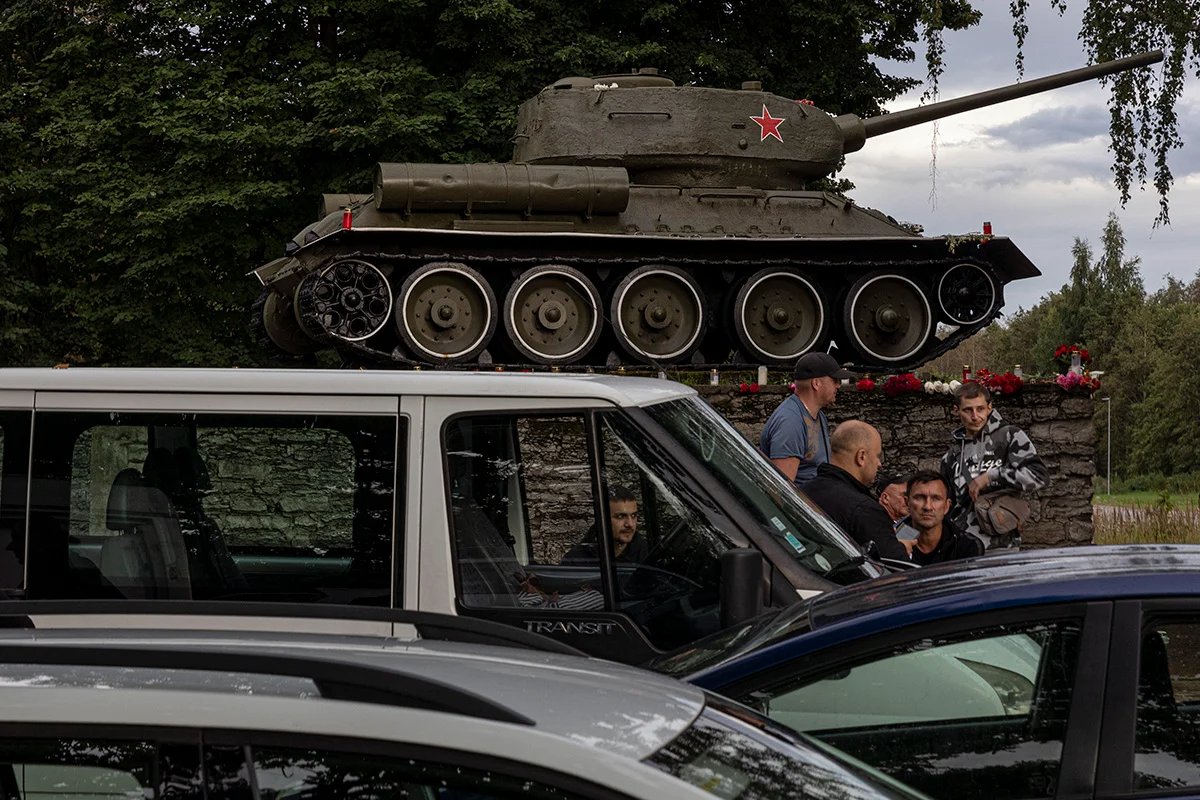
Photo by Vlad Dokshin / Especially for Novaya Gazeta.Europe
‘They are splitting us’
Dmitry, 35, is one of those opposing the tank removal. He is tall, slender, tanned and has curly blonde hair. When asked about his job, he says, “let’s say a driver.” Dmitry is on leave now and can spend a lot of time by the tank, he even spent nights near it. He is an Estonian citizen, just like his whole family, and cannot “just leave everything behind and move to Russia where memories are honoured.” Dmitry told me that these developments outraged him so much that he is “very close to start looking into visa issues” or “apply for asylum in Russia.”
“We are one in saying that [the monument] shouldn’t be removed. Stroll around town, ask anyone, you won’t miss. Everyone between the ages of 12 and 70, I guess. The city authorities do not even see the point in conducting polls because they know very well that 99.9% will vote for leaving it as it is,” Dmitry says.
Those around interrupt the conversation to support his view. “Yes, that’s it, you are right!”
“They want to incite a domestic conflict. We are also Estonians, I am an Estonian citizen. I speak Russian, live in Narva, but I pay my taxes and have the same rights as other Estonians. Even Raik came to drive a wedge between us. She says that the Estonian side should be understood as well. So, the mayor’s office is splitting us,” Dmitry believes.
According to him, the local authorities are scared to go against the government and decided to oppose the people. Meanwhile, the government uses the tank removal “to drive Russians out of here” and in fact “Estonians see us as third-rate people.” To prove this, Dmitry says that “everything is in a state of disrepair” in Narva and there’s now more Estonian speech on the streets.
“It is all done to start a war,” Dmitry concludes.
“With Russia?”
“God, Russia is so big. What do they need these Baltic States for?” a young brunette sitting next to Dmitry joins the conversation.
“You are not quite right here,” Dmitry interrupts her.
“Listen, our guys are spilling their blood there, they’ve been there for the whole of summer and spring,” the woman continues with anguish. “For people not to suffer and die, so that they are not bombed by fascist troops.”
“And by the way, the tank has it in Estonian about the fascists, about who came and who liberated,” she gestures towards the monument.
“Our grandads closed the issue, but it’s all happening again,” agrees a senior man with a moustache.
“But there will be a war here, I truly believe this. The Estonian government is doing all in its power to unleash a war,” Dmitry insists.
“They continue to segregate people, they cannot just let it go. So, you should take care of your history and not meddle with ours, you do have it, right? I am speaking to Estonians now,” the woman says. She says that she now lives in Sevastopol, but she originally comes from Narva and came here to “look at this travesty.”
“What can be done to avoid a war in Estonia?”
“This is a good question. Just don’t interfere with anything here because Narva is a separate state where not every Estonian person would go to. So, it turns out that a city turned against the state. Just like… Donbas. That’s the story.”
Intergenerational issue
Local politicians also worry about unity within Estonian society. The
next day after Kallas visited Narva, the Novaya Gazeta. Europe correspondent
met with Denis Larchenko, a member of the Narva city council from the Eesti 200
liberal political party.
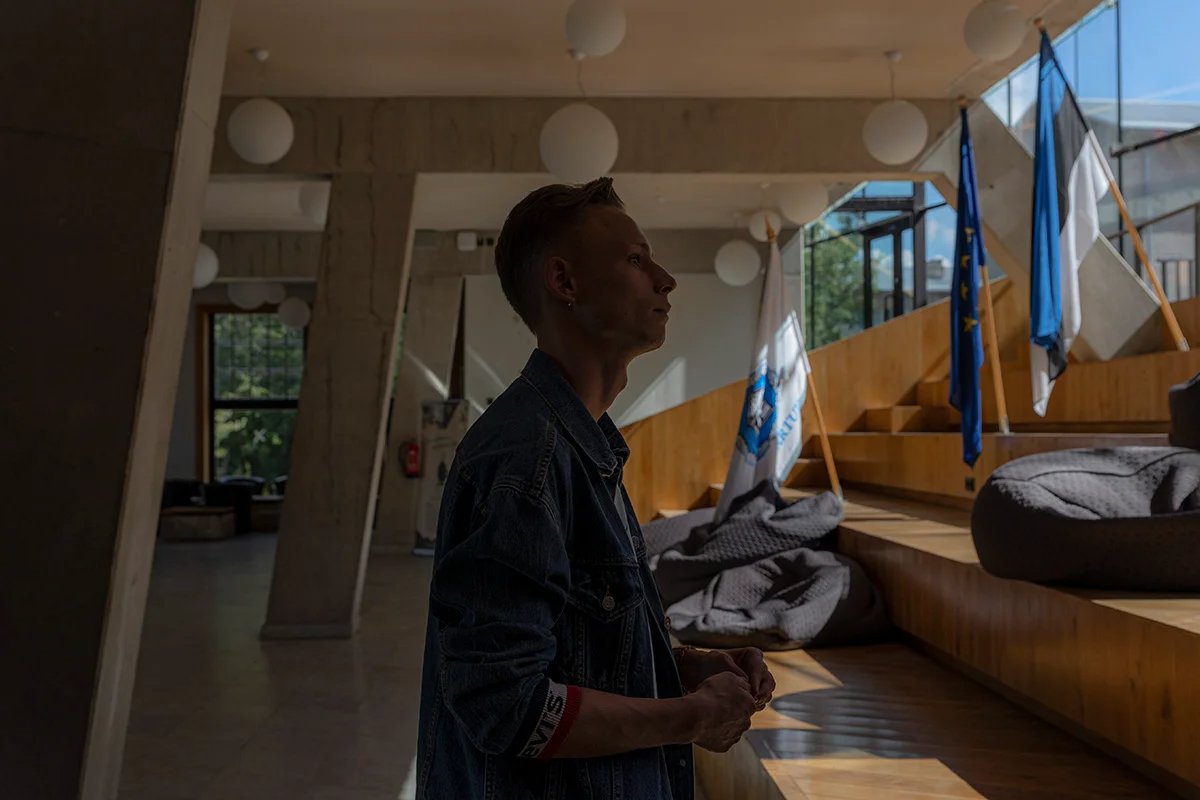
Denis Larchenko. Photo by Vlad Dokshin / Especially for Novaya Gazeta.Europe
Denis looks much younger than his age, 29, and does not have the appearance of a typical politician. He is also different from the people who were trying to protect the tank. A slim blond man with styled hair, perfect slightly tanned skin, stud earrings and a great taste in fashion. Our meeting takes place in the Narva College of the University of Tartu.
The building is situated in the Town Hall Square, the heart of Narva. Its modern look and vibe are strikingly different to other typically Soviet buildings around it. Although, it must be said they seem to be in perfect condition, probably due to a recent renovation.
«A college in Estonia is a higher education institution that you won’t enter without knowing the Estonian language. The vice-rector for the academic work of the University of Tartu used to say that our college represents something like Estonia’s embassy to Narva. Katri Raik headed the college for a while and now she is the Narva Mayor. Many people who now study and work here are interested in the public life of the city, region, and country, they are engaged in politics,» Denis speaks in Russian with a barely noticeable accent.
Larchenko grew up in Narva in a Russian-speaking family, his parents do not speak Estonian. However, the politician notes that he has always been more open to Europe rather than Russia. At the age of 18, he even left Narva and moved to Canada after failing to find a common ground with his parents but later returned home.
«I have always been very aware that I do not live in Russia. When my parents and I used to discuss Estonia’s domestic political issues, they were retelling me the agenda of Russian TV channels which was driving me mad. I used to tell them, ‘Look outside and show me NATO soldiers here,» Denis says. «We have a good relationship now and you won’t find them near the tank monument.»
According to him, some people in Narva do not want the accept the fact that the city is a part of Estonia and want to live «like in Russia.» These people do not learn Estonian, are not integrated into the Estonian society, and do not understand why their children need that.
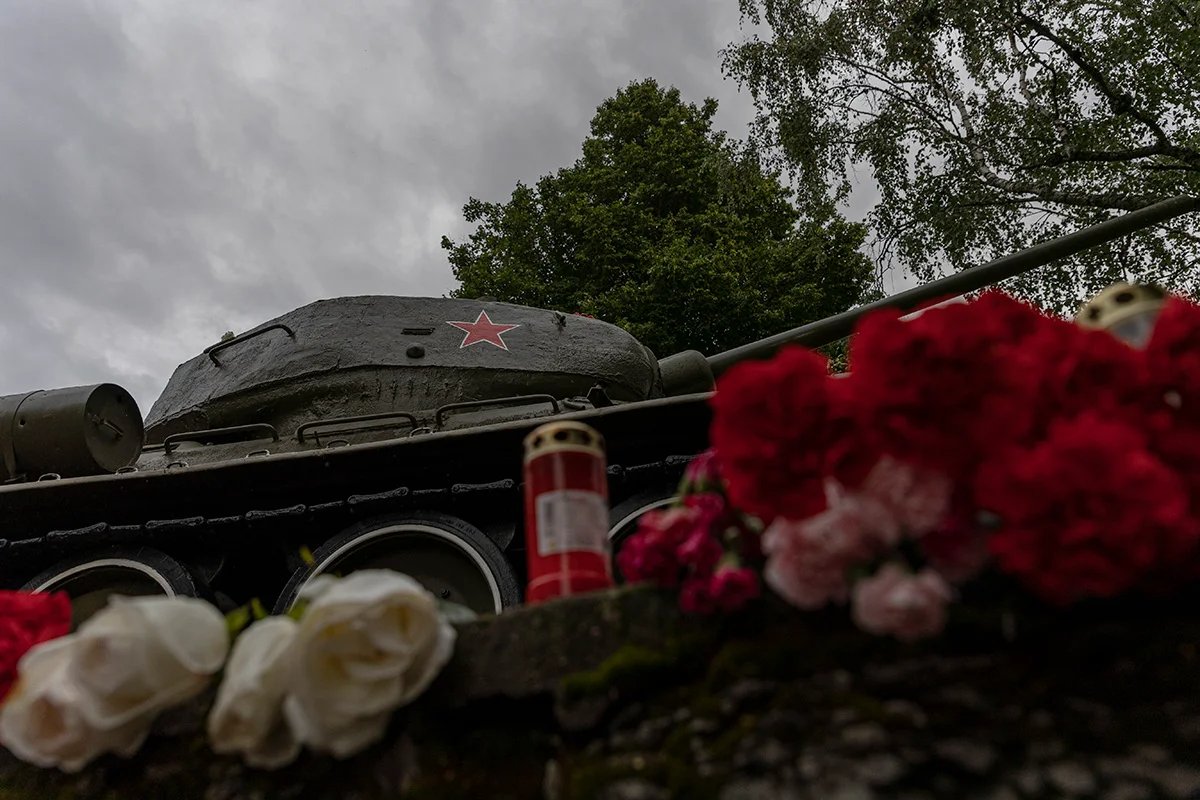
Photo by Vlad Dokshin / Especially for Novaya Gazeta.Europe
“This is an intergenerational issue. On the one hand, there is an adult population, people who lived their lives and considered themselves Russians with a Russian soul. However, in the 30 years since the Soviet Union collapsed a new generation has emerged who recognize that they are Russian speakers but Estonians at the same time: ‘I was born here, I accept the constitution of this country and consider myself a part of the Estonian society rather than the Russian one’. And the number of these people has grown.”
The politician underlines that the people who came to the tank’s defence, the most active residents of Narva, are mostly aged over 40.
They are insulted by the decision to remove the monument. But it would be wrong to assume that they speak on behalf of everyone in the city.
“The tank definitely remains valuable for some city residents, it is especially important on 9 May. However, people visit it less often nowadays, not everyone goes there to take wedding pictures. New places emerge in the city where Narva residents want to go to take photos. And if we are talking about symbols of Narva, the main sight of the city is definitely the Narva Castle (a medieval fortress located on the riverbank near the Russian border — Novaya Gazeta. Europe),” Denis notes.
Larchenko stresses the significance of the fact that all factions of the Narva city council managed to agree with each other despite their differing views on the government’s decision to take down the tank and united for the removal to be as painless as possible for the locals.
At the same time, all council members understood that the very idea of removing the monument from its usual place is a deeply unpopular decision. The residents would be angry in any way.
“Now is not the right time to take down the tank if you look at the judgment of people in Narva. However, the government that raised the issue is responsible for the whole of Estonia, it cannot only be grounded in what Narva people want,” Denis says.
“The state says that any monument related to the Soviet times is not acceptable in public spaces due to history. For Estonia, the end of [Europe’s part of the Second World] War is a certain loss. And not just a loss of human futures after people were deported from the country but also the loss of autonomy through occupation.”
“All these wounds of the Estonian society burst open at the backdrop of the war in Ukraine. Emotions run high in society and primarily among the Estonian-speaking people whose parents and granddads were deported. All those who view this issue very seriously.”
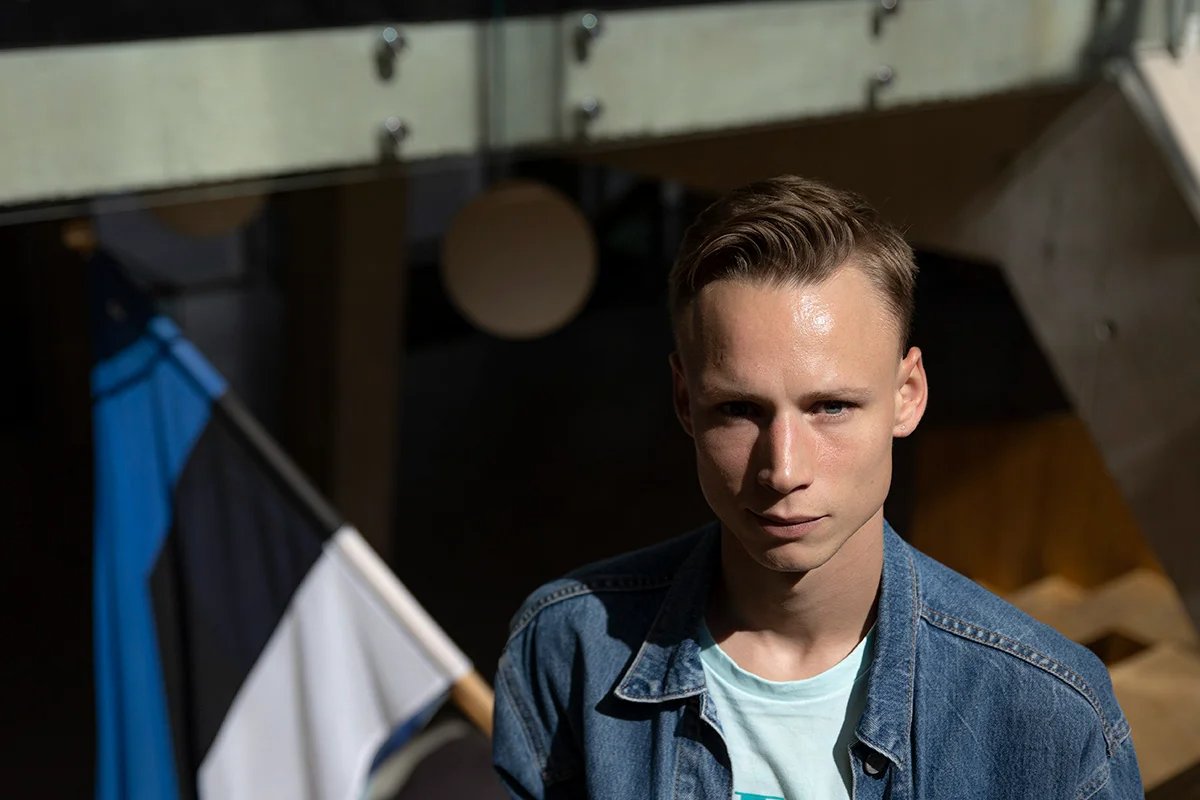
Denis Larchenko. Photo by Vlad Dokshin / Especially for Novaya Gazeta.Europe
Tank of contention
The conversation with Denis Larchenko took place a week before the sudden removal of the monument by the government. It then seemed like a compromise was reached between the Estonian government, city authorities and Narva residents.
Following the visit of Kallas to Narva on 8 August, the authorities announced that the monument would be taken down within 2 weeks and would remain in the city. It was supposed to later be transported to a museum or a memorial.
“I can assure you that monuments with Soviet symbols will be relocated with respect. History needs to be remembered, respected, and explained. It helps us to hear and understand each other. <…> We have different pasts but the same future. And we should focus on this future,” said Kallas, underlining that the monument still needed to be removed as soon as possible.
At the same time, from the legal point of view the decision was yet to be made. The law stipulated that the next city council meeting which could adopt such a decision was to take place at least 4 working days after the previous one, or not earlier than 15 August.
Estonian ministers were jumping at any opportunity until the end of the week to rebuke Narva council members that they are lingering with the removal, forgetting (or not knowing) about the legal timeline for decision-making. The local authorities, including the mayor, were resolutely repelling government attacks, pointing out that they are free to independently handle the city property and estate.
The approach chosen by the government of Estonia, a country where citizens are used to address many issues at the local level, outraged not only those who defended the monument but also local politicians. Katri Raik even accused Interior Minister Lauri Läänemets of being biased against Narva. She said that Tallinn was debating a similar issue in June and no decision was made, but the government is not rushing the capital for some reason.
On 15 August, the city council once again failed to debate the controversial move. The members said that the sudden amendments were to blame: they were tabled at the last moment and were not agreed. The local authorities announced that the issue would be discussed the next day. However, they did not have the opportunity to do so. The government intervened and removed the tank even before the meeting.
Narva did not appreciate this intervention. Some local politicians said they would go to court to defend constitutional rights of residents, slamming the government decision as unacceptable and groundless.
The mayor emotionally stressed that she would not run in the next parliamentary elections to avoid sitting in the same hall with the people who are capable of making “this decision and implementing it in such a way.” Raik also hinted that some members of the city council facilitated the government by sabotaging the discussion of the tank removal on 15 August. According to the mayor, it was done by the opposition politicians who seek to score points with their voters ahead of the legislative elections. It is easier to win votes by criticising the government’s move rather than to reach an agreement with Tallinn to jointly remove the monument.
The Eesti 200 party, which Denis Larchenko represents, announced that it would quit the Narva city council coalition due to the “political cowardness” of their colleagues and the lack of will to work for the changes that Narva needs. Therefore, Narva’s ruling faction collapsed, and the city council members will need to create new coalitions.
Police officers are now guarding the place where the tank used to stand. The authorities are cautious of any conflicts that can emerge out of nowhere, literally. After the cordons were lifted, people gathered at the scene. Several dozens of people, whole families at times, brought flowers and candles. Cars that were passing by were honking in support of them.
The police soon reported that 8 people were detained for calls to violence to oppose the removal. However, no mass protests took place.
Делайте «Новую» вместе с нами!
В России введена военная цензура. Независимая журналистика под запретом. В этих условиях делать расследования из России и о России становится не просто сложнее, но и опаснее. Но мы продолжаем работу, потому что знаем, что наши читатели остаются свободными людьми. «Новая газета Европа» отчитывается только перед вами и зависит только от вас. Помогите нам оставаться антидотом от диктатуры — поддержите нас деньгами.
Нажимая кнопку «Поддержать», вы соглашаетесь с правилами обработки персональных данных.
Если вы захотите отписаться от регулярного пожертвования, напишите нам на почту: [email protected]
Если вы находитесь в России или имеете российское гражданство и собираетесь посещать страну, законы запрещают вам делать пожертвования «Новой-Европа».
